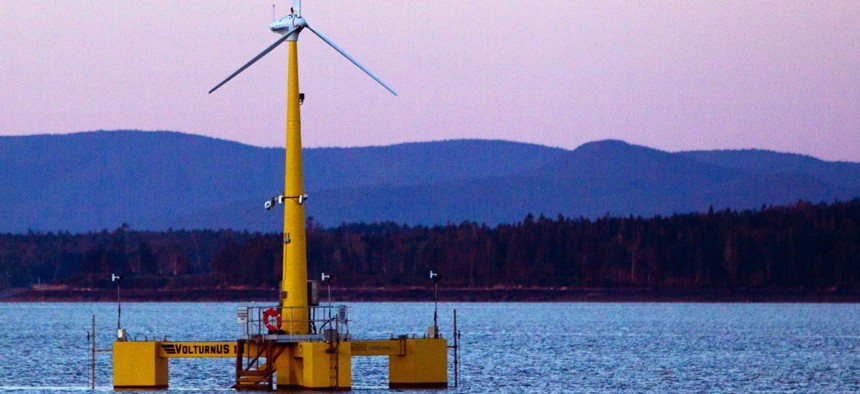Maine’s Offshore Wind Promise Goes Unfulfilled, Advocates Say

University of Maine's prototype wind turbine generator off the coast of Castine, Maine. Robert Bukaty / AP Photo
Proponents of the renewable energy hope the state’s next governor embraces new technology local universities are developing to advance the industry.
While other New England states have moved forward in embracing offshore wind projects, Maine has remained the lone holdout. But that could change when a new governor is elected in November.
Under former Gov. John Baldacci, a Democrat, the state’s 2006 energy plan included 5,000 megawatts of wind energy by 2030. However, Republican Gov. Paul LePage has been an “opponent of renewable energy more generally,” said Ryan Wallace, Maine Center for Business and Economic Research director.
With LePage termed out, leaving office at the end of the year, offshore wind proponents want his successor to revitalize momentum by creating political certainty for potential investors in the industry.
“Policymakers need to decide to put in place some of these similar procurement goals Massachusetts, Rhode Island, New Jersey and New York have put in place,” Wallace told Route Fifty. “Tied to that is development of an onshore industry.”
New York is eyeing 800 megawatts of wind power within two years and New Jersey 3,500 megawatts by 2030. More than 375,000 homes at once can be powered with 1,000 megawatts of energy, according to an American Jobs Project report released earlier this month.
A potential policy roadmap for Maine on the issue of offshore wind, the report argues the state could benefit from the developing regional market by more than 2,100 jobs. The local workforce’s knowledge of the composites industry and the Gulf of Maine marine environment—coupled with next-generation floating offshore wind turbine platforms the University of Maine is developing—provides a competitive advantage.
The state will need to focus on the local market and consider different options for procuring offshore wind energy. Power purchase agreements are customary, but procurement tax credits would support an ecosystem of innovation, according to the AJP report.
Workforce development is another area an offshore wind-minded governor would need to make strides in, but Maine’s cities are only just beginning to wrap their heads around the potential.
“We have not yet had any earnest conversations about offshore wind,” Julie Rosenbach, South Portland’s sustainability coordinator, told Route Fifty by email. “We are in the process of developing a citywide climate action and adaptation plan that will set a vision for greenhouse gas reductions of 80 percent by 2050. We are doing this in partnership with Portland. Our plan will identify action items that the city can pursue to move toward that vision. We are just beginning work on it.”
LePage isn’t the only Maine politician skeptical of wind power.
In December, the town of St. George’s Select Board voted to oppose the Maine Aqua Ventus pilot project, which the University of Maine is part of, because the proposed underwater energy transmission cable might hurt local fishing industries. The cable would have come ashore in Port Clyde, Maine, but the route was abandoned the following month in favor of one of 11 other as-yet-unannounced proposals.
VolturnUS, the floating hull designed by the university, will hold two 6 megawatt turbines south of Monhegan Island—further out at sea, at deeper depths than is typical. A cheaper alternative to traditional wind farms, the Maine Public Utilities Commission withdrew support for Aqua Ventus’ proposed rates earlier this month, citing declining electricity costs elsewhere and opposition to subsidies.
In January, LePage created a commission to study offshore wind’s impacts on tourism and imposed a moratorium to block new projects in the mountains and along the coast. He has been one of only two East Coast governors to back the Trump administration’s offshore drilling plan.
“The governor is not an opponent of offshore wind or of renewables in general,” said spokeswoman Julie Rabinowitz. “This is a continued, deliberate and convenient mischaracterization of the governor’s position by those seeking government and ratepayer subsidies for their renewable business interests.”
LePage supports all options that lower the cost of energy for citizens and businesses, she continued, and “neither taxpayers or ratepayers should be expected to bear the burden of experimental technologies.”
Auto-body entrepreneur Shawn Moody is the Republican nominee running to succeed LePage. Moody’s campaign didn’t immediately respond to Route Fifty’s request for comment on his energy policy.
Exactly who will be the Democratic nominee in the fall election remains unknown, as state officials are still tabulating the state’s first ranked-choice vote, where candidates are ranked based on voter preference to determine the winner. But the Maine Democratic Party called every Republican candidate out in February for failing to take a position on President Trump’s offshore drilling announcement.
Several Democratic candidates have made offshore wind part of their platform—attorney Adam Cote even going so far as to call for investment in floating tech.
Frontrunner and state Attorney General Janet Mills pushed back against LePage’s moratorium executive order, arguing interested companies could still apply for permits.
“Maine has everything it needs, other than the right leadership, to lead on solar, properly-sited onshore and offshore wind, tidal, biomass and other renewable sources while creating thousands of good jobs across our state,” Cote said in a statement.
Dave Nyczepir is a News Editor at Government Executive’s Route Fifty and is based in Washington, D.C.
NEXT STORY: Complete Figures for State Disaster Spending Are Hard to Come By






